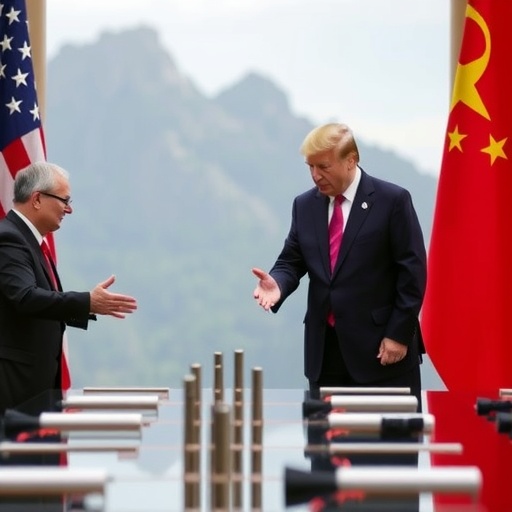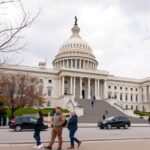US-China Trade Talks Intensify in Malaysia as Rare Earth Restrictions Spark Tariff Threats Ahead of Trump-Xi Summit
In a high-stakes diplomatic dance that could reshape global supply chains, top US and Chinese officials convened in Kuala Lumpur, Malaysia, on Monday to hash out escalating tensions over rare earth minerals. With China tightening its grip on these critical resources—vital for everything from electric vehicles to defense systems—the US has warned of imposing steep tariffs if no compromise is reached before the anticipated Trump-Xi summit. The meeting, shrouded in secrecy, underscores the fragile state of US-China trade talks, where billions in economic interests hang in the balance.
Rare earth elements, a group of 17 metals essential for high-tech manufacturing, represent a flashpoint in the ongoing US-China rivalry. China controls over 80% of the world’s supply, according to the US Geological Survey, and recent export controls have sent shockwaves through American industries. As negotiators from both sides exchanged proposals behind closed doors, sources close to the talks revealed that the agenda dominated discussions on how to prevent a full-blown trade war revival under a potential second Trump administration.
The urgency of these US-China trade talks cannot be overstated. With the US presidential election looming and President-elect Donald Trump signaling a return to aggressive tariff policies, the Malaysia summit serves as a crucial prelude to what could be a pivotal Trump-Xi summit in early 2025. Failure here might trigger tariffs as high as 60% on Chinese imports, echoing the levies imposed during Trump’s first term that cost US consumers an estimated $195 billion, per a 2023 study by the Federal Reserve Bank of New York.
Malaysian Summit Becomes Battleground for Rare Earth Export Controls
The choice of Malaysia as the venue for these US-China trade talks was no accident. As a neutral ground in Southeast Asia, Kuala Lumpur offered a low-profile setting away from the glare of Washington or Beijing. US Trade Representative Katherine Tai led the American delegation, joined by officials from the Department of Commerce and national security advisors. On the Chinese side, Vice Premier He Lifeng spearheaded the team, emphasizing Beijing’s stance on protecting its strategic resources.
At the heart of the dispute lies China’s recent imposition of stricter rare earth export controls. In late October, Beijing announced enhanced scrutiny on shipments of neodymium and dysprosium—key rare earths used in magnets for wind turbines and fighter jets—citing national security concerns. This move, which analysts link to retaliatory measures against US chip export bans, has already caused prices to surge by 25% in global markets, according to data from Argus Media. “China’s actions are a direct challenge to our supply chain security,” Tai stated in a pre-summit briefing, underscoring the US push for diversified sourcing.
During the two-day talks, negotiators delved into specifics. The US proposed a bilateral agreement allowing increased rare earth flows in exchange for eased restrictions on American technology transfers. Chinese officials, however, countered with demands for the lifting of existing US tariffs on solar panels and batteries, sectors where China holds a dominant market share. A senior US official, speaking anonymously, described the atmosphere as “tense but productive,” with late-night sessions extending past midnight.
Historical context adds weight to these proceedings. The US once led in rare earth production until the 1990s, when environmental regulations and cheaper Chinese labor shifted dominance eastward. Today, the Mountain Pass mine in California, operated by MP Materials, supplies only about 15% of US needs, forcing reliance on imports. This vulnerability was exposed during the 2010 Senkaku Islands dispute, when China briefly halted exports, causing prices to quadruple overnight.
Rare Earth Squeeze Threatens US Tech and Defense Sectors
The rare earth dispute is more than an economic tussle—it’s a national security imperative for the US. These minerals are indispensable for semiconductors, electric motors, and missile guidance systems. The Department of Defense estimates that a prolonged shortage could delay F-35 production by up to 18 months, while the electric vehicle industry, aiming for 50% market penetration by 2030, faces component shortages that could add $1,000 to each car’s cost.
Industry leaders have sounded the alarm. Elon Musk, CEO of Tesla, tweeted last week, “Rare earth dependency on China is a ticking time bomb for EV innovation.” Similarly, a report from the Semiconductor Industry Association warns that without resolution, US chipmakers like Intel and NVIDIA could see production costs rise by 10-15%. Statistics paint a grim picture: China exported 52,000 metric tons of rare earths in 2023, but new controls could slash that by 30%, per BloombergNEF projections.
In response, the US has ramped up domestic efforts. The Inflation Reduction Act allocated $370 million for rare earth processing facilities, and partnerships with Australia and Canada aim to build alternative supply chains. Yet, experts like James Kennedy, CEO of ThREE Consulting, argue that scaling up will take years. “We’re playing catch-up in a game where China has a decade-long head start,” Kennedy told Reuters. During the Malaysia talks, US negotiators highlighted these investments to press for immediate concessions on rare earth exports.
Environmental and ethical angles also surfaced. Rare earth mining is notoriously polluting, with China’s lax regulations leading to contaminated water sources in Inner Mongolia. US advocates pushed for sustainable practices in any deal, potentially opening doors for green technology collaborations. A leaked memo from the talks suggested China might agree to joint ventures in Africa, where untapped deposits could benefit both nations.
Tariff Threats Loom Large as Trump-Era Policies Resurface
As US-China trade talks progressed in Malaysia, the shadow of impending tariffs loomed ever larger. President-elect Trump, fresh off his election victory, has vowed to impose 60% tariffs on all Chinese goods and up to 100% on electric vehicles—a escalation from the 25% duties of his first term. These measures, if enacted, could generate $2.5 trillion in revenue over a decade but risk inflating US inflation by 1.5 percentage points, according to Moody’s Analytics.
Chinese officials responded with measured defiance. “Tariffs hurt both sides,” Vice Premier He Lifeng remarked during a break in negotiations, echoing Beijing’s narrative of mutual economic harm. Yet, behind the rhetoric, China has prepared countermeasures, including potential bans on rare earths to critical US allies like Japan and South Korea. The 2018-2019 trade war saw US agricultural exports to China plummet by 50%, costing farmers $27 billion; a repeat could devastate Midwest economies.
Market reactions were swift. The Dow Jones Industrial Average dipped 1.2% on news of the summit’s start, while rare earth stocks like Lynas Rare Earths soared 8%. Economists warn of broader ripple effects: a full tariff rollout could shave 0.5% off global GDP, per the International Monetary Fund, with supply chain disruptions hitting Europe and Asia hardest.
Within the talks, tariff de-escalation emerged as a bargaining chip. The US offered to pause new levies if China commits to stable rare earth supplies for five years. In turn, Beijing sought exemptions for its $500 billion in annual US exports, particularly in consumer electronics. Negotiators cited the Phase One trade deal of 2020, which stabilized relations temporarily but fell short on enforcement, as a cautionary tale.
Path to Trump-Xi Summit Hinges on Malaysian Breakthroughs
With the Malaysia summit wrapping up on Tuesday, all eyes turn to the potential Trump-Xi summit, tentatively slated for Davos or Singapore in January. This face-to-face meeting between the two leaders could either defuse or ignite the rare earth crisis. Trump, known for his deal-making bravado, has already floated the idea of a “grand bargain” encompassing trade, technology, and even geopolitical issues like Taiwan.
Preparations from the Kuala Lumpur talks will shape the summit’s agenda. A joint statement is expected soon, outlining progress on rare earth quotas and tariff suspensions. Optimists point to shared interests: both nations face domestic pressures—US inflation concerns and China’s slowing growth at 4.6% in Q3 2024—to avoid escalation.
Yet, challenges persist. Hawkish voices in Washington, including Senator Marco Rubio, urge a hardline stance, while Beijing’s nationalists decry any concessions as weakness. International observers, like the World Trade Organization, have called for multilateral involvement to prevent a bilateral deadlock.
Looking ahead, a successful resolution could spur innovation in recycling rare earths, with US firms like Apple investing $50 million in recovery tech. Conversely, failure risks a fragmented global economy, where alliances like the Quadrilateral Security Dialogue accelerate de-risking from China. As one analyst put it, “This isn’t just about minerals; it’s about who controls the future of technology.” The stakes for US-China relations have rarely been higher.
The implications extend globally. Emerging markets in Vietnam and Indonesia could emerge as rare earth hubs, diversifying away from China’s monopoly. For consumers, stable supplies mean affordable EVs and gadgets; disruptions could mean higher prices and delayed green transitions. As negotiators depart Malaysia, the world watches, hoping for a deal that averts economic turmoil.









